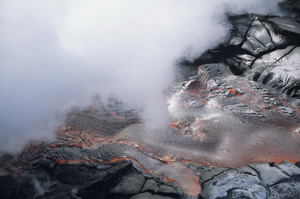
Sherlock Holmes himself would be hard pressed to figure out conflicting redox proxies, says a geochemist at Washington University in St. Louis.
In The Sign of Four Sherlock Holmes tells Watson he has written a monograph on 140 forms of cigar-, cigarette- and pipe-tobacco, “with colored plates illustrating the difference in the ash.” He finds the ash invaluable for the identification of miscreants who happen to smoke during the commission of a crime.
But Sherlock Holmes and his cigarette ash and pipe dottle don’t have a patch on geologists and the “redox proxies” from which they deduce chemical conditions early in Earth’s history.
Redox proxies, such as the ratio of chromium isotopes in banded iron formations or the ratio of isotopes in sulfide particles trapped in diamonds, tell geologists indirectly whether the Earth’ s atmosphere and oceans were reducing (inclined to give away electrons to other atoms) or oxidizing (inclined to glom onto them).
It makes all the difference: the bacterium that causes botulism and the methanogens that make swamp gas are anaerobes and thrive in reducing conditions. Badgers and butterflies, on the other hand, are aerobes, and require oxygen to keep going.
In the July issue of Nature Geoscience, Washington University in St. Louis geochemist David Fike, PhD, gives an unusually candid account of the difficulties his community faces in correctly interpreting redox proxies, issuing a call for denser sampling and more judicious reading of rock samples.
The world ocean
Fike, assistant professor of earth and planetary sciences in Arts & Sciences, focuses on the dramatic change from anoxic to oxygenated conditions in the world’s oceans that preceded the Ediacaran period (from 635 to 542 million years ago) when the first multicellular animals appeared.

It’s complicated
“Recent geochemical evidence indicates that, at least locally, ferruginous (iron rich) or even sulphidic (sulfur rich) conditions persisted through the Ediacaran period, long after the Great Oxygenation Event,” Fike says.
“Things are much more complicated than we had supposed.”
“As a community, we don’t have a good sense of the spatial variation of these zones within different bodies of water, &rldquo; Fike says.
“What’s more, different assessments can arise from the interpretation of different geochemical proxies, from physical separation between different ocean basins, or from the reworking of sediments after deposition,” he continues.
The underlying problem is a low sampling rate. “As we try to unravel these changes in Earth’s history, ” Fike says, “we often don’t have 100 different places where we can measure rocks of the same age. We’re stuck with a few samples, and the natural tendency is to take your rocks and extrapolate.”
The only way “to wring order from the chaos,” Fike says, is to develop a full three-dimensional model of the Earth that has enough spatial resolution to wash out bad data.
A cautionary tale
At the same time, Fike acknowledges that spatial variability in redox proxies may make many geologists feel ill at ease because it might instead reflect an unusual depositional context or the reworking of the proxy after deposition instead of a signficant change in geochemistry.
By way of illustration, he describes a study of Amazonian mud belts, published this year by Robert Aller of Stony Brook University and colleagues in Geochimica et Cosmochimica Acta.
“The Amazon dumps mud rich in organic material into the Atlantic,” Fike says. &rdquot;The mud is deposited and the oxygen in it is consumed by biological activity, but then a storm churns it up, it gets reoxygenated, and redeposited. And this process happens over and over again.”
By the time the mud becomes sediment, its chemistry is very different from what it was when it was first deposited.
“The redox indicators for the Amazonian sediments suggest that they were deposited under anoxic, sulfate-poor conditions, but we know they were deposited in well-oxygenated, sulfate-rich marine waters,” Fike writes.
It is as if the murderer had deliberately removed cigar ash and substituted cigarette ash at the scene of the crime.
“Much work remains ahead of us before we can have a true sense of the three-dimensional redox structure of the oceans and how it varied through time,” Fike concludes.